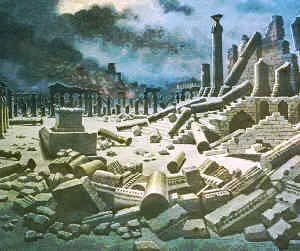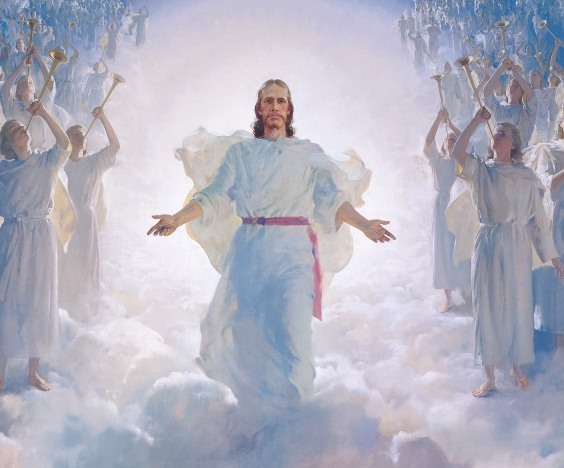Coming Soon: Was Jesus wrong?
In Revelation, Jesus says that He is “…coming soon” (Revelation 22:20). However, it is now 2,000 years later and we haven’t yet had the Second Coming. Dr Barber, in the second chapter of his book, addresses the obvious question: “Was Jesus wrong?”.
How soon is soon?
Some exegetes solve this problem of Jesus’ absence by pointing to St. Peter’s second epistle:
But do not ignore this one fact, beloved, that with the Lord one day is as a thousand years, and a thousand years as one day – 2 Peter 3:8
These exegetes make the argument that Jesus is indeed coming “soon”, but our version of “soon” is not the same as His.

Matthew’s Apocalypse
The above explanation works reasonably well, until we look at the apocalyptic passages found in the Gospels and find that Jesus gets quite specific about His timeframe:
“Immediately after the tribulation of those days the sun will be darkened, and the moon will not give its light, and the stars will fall from heaven, and the powers of the heavens will be shaken; then will appear the sign of the Son of man in heaven, and then all the tribes of the earth will mourn, and they will see the Son of man coming on the clouds of heaven with power and great glory…
Truly, I say to you, this generation will not pass away till all these things take place” – Matthew 24:29-30, 34
The Greek word for “generation” in Greek is “gene” and was generally considered to span forty years. Since Jesus’ words were said in around AD 30, that would place his coming at about AD 70. However, it is currently AD 2013, so what happened?

Keeping the Temple in Mind
To understand Jesus’ words in Matthew’s Gospel we must look to their context. In the beginning of the chapter we read:
“Jesus left the temple and was going away, when his disciples came to point out to him the buildings of the temple. But he answered them, “You see all these, do you not? Truly, I say to you, there will not be left here one stone upon another, that will not be thrown down“ – Matthew 24:1-2
It is therefore in the context of the Temple that we should understand Jesus’ words. To understand what Jesus says we must first understand what the Temple in Jerusalem meant to the people of Israel.
Put simply, the Temple was the centre of their world. In fact, they saw it as a miniature model of the world. If one reads the account of its construction by Solomon one will see the number “seven” appear an awful lot, pointing the reader towards the Book of Genesis and the account of creation.
Since the Temple was a symbol of the world, its destruction symbolized the world’s end. This is why we always find Jesus’ apocalyptic messages always given in the context of the Temple.
Jerusalem’s Judgement
In the Old Testaments, the prophets spoke of the Lord’s “coming” as a judgment:
Behold, he comes up like clouds,
his chariots like the whirlwind;
his horses are swifter than eagles—
woe to us, for we are ruined! – Jeremiah 4:13
Earlier I said that, if a “generation” was regarded as forty years, then Jesus should have “come” in AD 70. Well, an important event did take place in AD 70. There had been a Jewish uprising against the occupying Romans. This insurrection was met with a bloody and ruthless Imperial response. Caesar’s armies marched upon Jerusalem and laid waste to it, destroying the Temple and slaughtering the people in the process.
To the First Century Jew, it was as if the world had ended. The Christians, however, were not in Jerusalem, having heeded the Master’s warnings and fled to nearby Pella.

So no literal end of the world?
It would be dangerous to conclude from this that, since Jesus’ words were fulfilled at the end of the First Century, then their meaning has been exhausted. However, this is not true. The destruction of the Temple was a preparation, a “dress rehearsal” for the end of the world. St. John’s Revelation wishes to teach us how to prepare for the real thing…
The article Coming Soon: Was Jesus wrong? first appeared on RestlessPilgrim.net


Pingback: Coming Soon: Was Jesus wrong? - CATHOLIC FEAST - Every day is a Celebration
Two organized groups remained: the Early Christians , and Pharisees . Some scholars, such as Daniel Boyarin and Paula Fredricksen, suggest that it was at this time, when Christians and Pharisees were competing for leadership of the Jewish people, that accounts of debates between Jesus and the apostles, debates with Pharisees, and anti-Pharisaic passages, were written and incorporated into the New Testament .
Hey Marco, welcome to the Restless Pilgrim and thank you for your comment!
Paragraph #126 of the Catechism agrees (to a certain degree) with what you say:
“The sacred authors, in writing the four Gospels, selected certain of the many elements which had been handed on, either orally or already in written form; others they synthesized or explained with an eye to the situation of the churches, the while sustaining the form of preaching, but always in such a fashion that they have told us the honest truth about Jesus“
It’s not that these exchanges were made up out of nothing, but they certainly were incorporated in the Gospels because of the clashes between the Jewish sects and the Early Church.
(In fact, this is one of the reasons for an early date for the composition of Matthew’s Gospel. That particular Gospel contains many references to the Sadducees, a group which was wiped out at the Fall of Jerusalem in AD 70 and thereby quickly rendered irrelevant to Early Christianity)
End of the world ? Or End of the age as in Jewish age ?
The problem with associating “end of the age” with what some call “the Jewish age” is that Jesus said in the Great Commission that he’d be with disciples “until the end of the age”. That’d implies he’d abandon His Church afterwards!